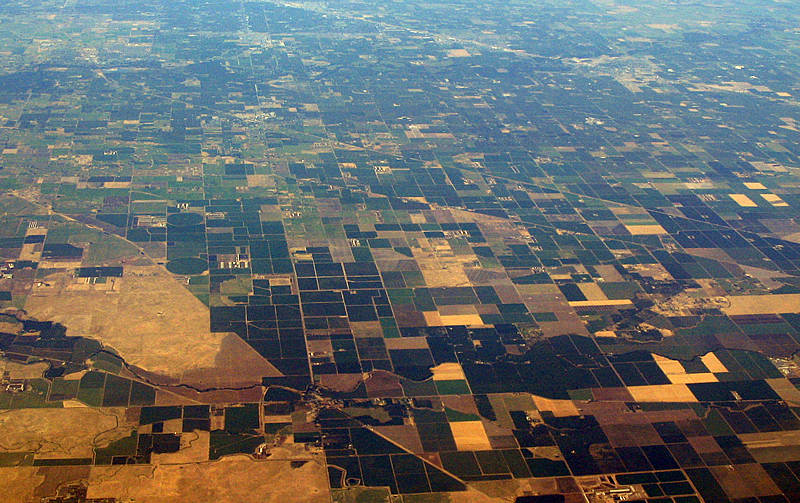This blog is co-authored with the California Water Data Consortium.
By Mike Myatt (Senior Director, Climate Resilient Water Systems – EDF) and Hannah Ake (Senior Program Manager – California Water Data Consortium)
A key first step toward managing groundwater sustainably in California, as required by the state’s Sustainable Groundwater Management Act (SGMA), is tracking how much water is being used and how much is available – otherwise known as water accounting – because you can’t manage what you don’t measure. This is especially true during drought.
To help groundwater agencies more easily track and communicate supply and demand, state water agencies, the California Water Data Consortium, and Environmental Defense Fund (EDF) announced a partnership last year to make an open-source Groundwater Accounting Platform (Platform) available to groundwater agencies. In the exciting latest news, three more water agencies have signed on to use the platform and help expand its functionality as the Department of Water Resources has committed more funding and expertise to further develop it. The Platform offers a readily accessible source code and is a cost-effective option for water managers to adapt and customize accounting practices; rather than developing their own tools from scratch.
Three New Partnerships Join the Groundwater Accounting Platform
These new partnerships and funding from the Department of Water Resources provide a huge opportunity to leverage additional Groundwater Sustainability Agency (GSA) leadership to improve the Platform and ensure its future scalability for California. EDF and the Consortium will be working with our new pilot partners, as well as two advisory groups, to further develop the Platform and ensure it remains an accessible and functional tool for GSAs and other interested parties across the state.
A tool to engage landowners on water budgets
The open-source Groundwater Accounting Platform is co-developed by EDF, Rosedale-Rio Bravo Water Storage District (RRBWSD), the California Water Data Consortium, Environmental Science Associates, and Olsson. The Platform was initially developed based on feedback from RRBWSD landowners who participated in workshops to ensure the Platform met their needs and was user-friendly. Trent Taylor, Water Resources Manager at RRBWSD says that improved water accounting has paid dividends in the district’s efforts to implement SGMA. “The Platform has been an invaluable tool for district water management purposes and also provides our landowners vital information for their decision-making processes. In addition to providing readily available, parcel-level water use estimates, it also enables landowners to make predictions based on historic demand. This information supports better planning that is good for both the landowner and the district and will be a necessary tool in achieving SGMA compliance now and in the future.”
Similarly, all three of the new partners, Merced Irrigation-Urban Groundwater Sustainability Agency, Pajaro Valley Water Management Agency, and Yolo County Flood Control and Water Conservation District, see the Platform as a way to support local decision-making by providing district managers and landowners with a state-endorsed accounting tool that supports communication of water budgets and accounting under SGMA.
The next phase of work will involve expanding the Platform to include scenario planning functionality using the open-source Groundwater Evaluation Toolbox Engine, or GET Engine, developed by Olsson. This addition will enable users to run model scenarios to assess the impacts of pumping, water trading, recharge, and other potential management scenarios. These scenario runs can support refinement of existing water budgets and the management actions to achieve long-term groundwater sustainability.
The Platform’s current ability to integrate information from OpenET and other sources, combined with GET, will allow GSAs to plan and prepare for consumptive use under different scenarios. The Platform is open-source software, offering increased flexibility and affordability, but that does not mean a lack of privacy. Landowners using the dashboard will only be able to access the data for parcels they own, or grant others access to. Customization and privacy is important, especially when local conditions vary and there is no one-size-fits-all solution for groundwater management. Open-source software enables this flexibility at a reduced cost.
You can learn more about our new pilot partners, and how they envision using the Groundwater Accounting Platform below.
The Groundwater Accounting Platform co-developed with RRBWSD lets landowners log in and easily check individualized water budgets for their parcels online much like one would balance their checking account. This screenshot is specific to the landowner dashboard and shows how much water has been allocated to a specific landowner (the red line) and cumulative monthly water use (blue bar graph).
Merced Irrigation – Urban Groundwater Sustainability Agency (MIUGSA)
The Merced Irrigation–Urban Groundwater Sustainability Agency (MIUGSA) was established in 2017 and is made up of seven member agencies representing both agricultural and urban groundwater users. MIUGSA is one of three GSAs that collaborated on a single Groundwater Sustainability Plan (GSP) in the Merced Groundwater Subbasin. The MIUGSA Board adopted both a groundwater allocation, and well registration policy in 2022.
MIUGSA sees the platform as an important tool to help landowners better understand their surface and groundwater water budgets as the groundwater allocation system is implemented, and plans to hold stakeholder workshops that feature the Platform. MIUGSA is also interested in exploring the potential for incorporating its well registration into the Platform, if feasible.
Eventually, MIUGSA aims to incorporate the Merced Water Resources Model, the model used for the Merced Groundwater Subbasin Groundwater Sustainability Plan (Merced GSP), with GET to test various modeling scenarios, such as recharge opportunities. Because GET can integrate with existing groundwater models, GSA staff will be able to project how groundwater recharge activities could contribute to meeting sustainability goals in the Merced GSP. Additionally, MIUGSA anticipates this being an effective resource in understanding the potential benefits to recharge, particularly in disadvantaged communities. This toolset will provide landowners with invaluable information when considering potential recharge opportunities.
Olsson’s GET tool lets groundwater agencies model scenarios to analyze potential benefits and impacts of groundwater recharge activities. This screenshot from Rosedale-Rio Bravo Water Storage District shows a scenario to explore the effect of a water trade on a disadvantaged community and domestic well.
Pajaro Valley Water Management Agency
The Pajaro Valley basin is a highly productive agricultural district that lies just north of Monterey at the mouth of the Pajaro River Watershed. The Pajaro Valley Water Management Agency (PV Water) was established in 1984, 30 years before SGMA was signed into law, to efficiently manage water supplies and reduce the effects of long-term overdraft in the region.
This long history of thoughtful and intentional management by growers and PV Water has helped shape what the Pajaro Valley is today, and has led to successful conservation programs, the development of data management systems, statewide partnerships, and significant community engagement. This innovative spirit makes the partnership with the Consortium and EDF on the Groundwater Accounting Platform a natural next step for the agency.
Brian Lockwood, General Manager and Hydrogeologist at PV Water elaborates: “PV Water’s staff is eager to bring our expertise to the table to help foster the success of open-source tools. We think data and visualization tools will be instrumental to the future success of our water conservation programs, and will empower our growers as they evaluate their consumptive use. Additionally, the Platform provides a great opportunity to be an engaged partner on statewide groundwater management sustainability efforts.”
Accordingly, PV Water hopes to use the Platform and the new GET integration to improve knowledge of water use by parcel and to identify conservation opportunities in its basin. Being able to compare metered production data with simulated data produced by the Pajaro Valley Hydrologic Flow Model, and consumptive use data collected by remote sensing technology such as Open ET, will be an informative exercise.
Yolo County Flood Control and Water Conservation District
Yolo County Flood Control and Water Conservation District (Yolo) is a conjunctive use management district in western Yolo County working closely with the Yolo Subbasin Groundwater Agency to identify and sustainably manage water supplies in the region. Kristin Sicke, General Manager at Yolo, says, “We are excited to use the Platform to find efficient and transparent ways to streamline water accounting in our area, and to ultimately provide a service for growers so that they can better prepare for upcoming irrigation seasons.”
Yolo sees the Groundwater Accounting Platform as a way to synthesize their conjunctive water supplies, and the agency hopes to explore how to integrate their surface water supply data alongside groundwater data in the Platform down the road.
The Future of The Groundwater Accounting Platform
All three pilots will be instrumental in the creation of additional features and functions for the Groundwater Accounting Platform, such as integration of additional data types, customizing date ranges for landowner water dashboards to see data over a specific period of time, and supporting scenario planning for multi-year allocations.
As these three water agencies roll out the Groundwater Accounting Platform with their regions, we expect to hear more new ideas on potential uses to more easily track groundwater in the state. We also know from our combined decades working in the water sector that collaboration can spark further innovation and creativity, and we are excited to see the new directions these partnerships, and other partnerships, take the Platform in California.
A public workshop is planned for spring 2023 to provide more information on this innovative tool, including how GSAs can engage in this effort. Subscribe to the Consortium’s listserv to receive project updates and additional information, or consult our fact sheet to learn more.
If you are interested in learning more about the Groundwater Accounting Platform and other similar projects, please contact the California Water Data Consortium or the Environmental Defense Fund.













